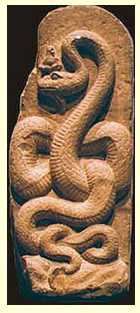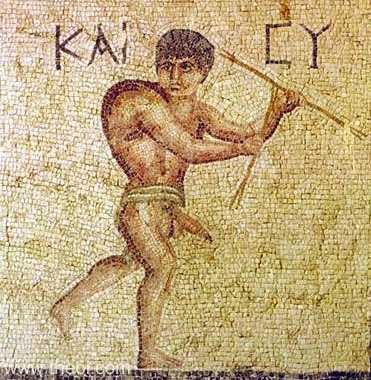Below, a statue of Antinous, a handsome youth who was the Roman Emperor Hadrian's (ruled ca. 117 AD) companion and lover who died under mysterious circumstances in Egypt. He is portrayed here as the Graeco-Egyptian Agathos Daimon, The Agathos Daimon Serpent is on his left forearm.
Below, the Agathos Daimon in the form a great serpent with a cock's comb (?) atop its head and a beard or goatee below its mouth. The bearded clothed bust in the niche above the serpent with a grain modius (a measuring bucket for wheat) on its head may be the alternate human representation of the Agathos Daimon? Does the cock's comb allude to cocks who crow at sunrise and the goatee to the setting sun as an aged man? The Agathos Daimone was assimilated to the sun-god.
Below, the Agathos Daimon shown with a sun disc atop its head. In texts it is associated or assimilated to the Graeco-Egyptian sun-god Helios-Horus and called "the Lord of the World."
Below. the Agathos Daimon as a large snake, with goatee under its chin; Greek: drakon (English: "dragon") meaning "large snake." The Agathos Daimon was assimilated to the Egyptian Ra or Re the sun-god (Greek Helios, Roman: Sol) and called "The Eternal Eye." Perhaps the "Eye of Ra" above the serpent's head alludes to its epithet "The Eternal Eye"? The eye represented the sun-god. In Egyptian myth the sun rises as a young man and sets as an aged man, perhaps this accounts for the Agathos Daimon's appearance in art forms as both a beardless young man and a mature bearded man?
Agathodaimon figurine in silver, 1st-2nd century AD a mature bearded (?) man holding a cornucopia or horn of plenty in left hand and a patera in his right hand. (Boston Museum of Fine Art)
Agathodaimon figurine in bronze of a beardless young man with a grain modius (?) atop his head and a sheaf of wheat (?) or a victory palm branch in his left hand (?) Alexandria, Egypt.
(Roman Period, 100-200 AD)
These images of the Agathos Daimone accompany my article on how Satan in the New Testament Book of Revelation came to be portrayed as a Dragon and the Serpent in the Garden of Eden. Please click here for more details.
Below, a mosaic, 2nd century A.D. showing the Agathos Daimon as a naked man holding spits (from the House of the Evil Eye, at ancient Antioch, Syria). This iconography seeks the blessing of good fortune on the house owner and it also wards off bad fortune from the kako daimon and the evil eye (The two Mosaics are at the Antakya Museum, Antakya, Turkey)
Below, another mosaic from the House of the Evil Eye, Antioch, 2nd century A.D. showing the
Kako Daimon (Caco Demon) or "Evil Spirit" naked, with enlarged penis between his legs. His brow is described as either possessing horns or wings. Near him is the "Evil Eye" being pecked at by a raven and stabbed by a trident and a sword, and attacked by a scorpion, snake, millipede, spotted leopard (or cat?) and dog.
Below a bronze sculpture of Sarapis-Amun-Agathodaemon,
a combining of several Egyptian gods (Athens, Greece Museum exhibit of Egyptian Art, Greco-Roman Era).
Below the Agathodaemon enthroned as ruler of the world (the orb held in its hand symbolizing the world) adored by Thoth, an Egyptian baboon-god who greets at sun-rise the sun with barking. The Agathodaemon is here being assimilated to the sun as ruler of the world (drawing after a gemstone).
Please click here for more pictures of the Agathodaemon in wall frescos found at Pompeii, Italy.









